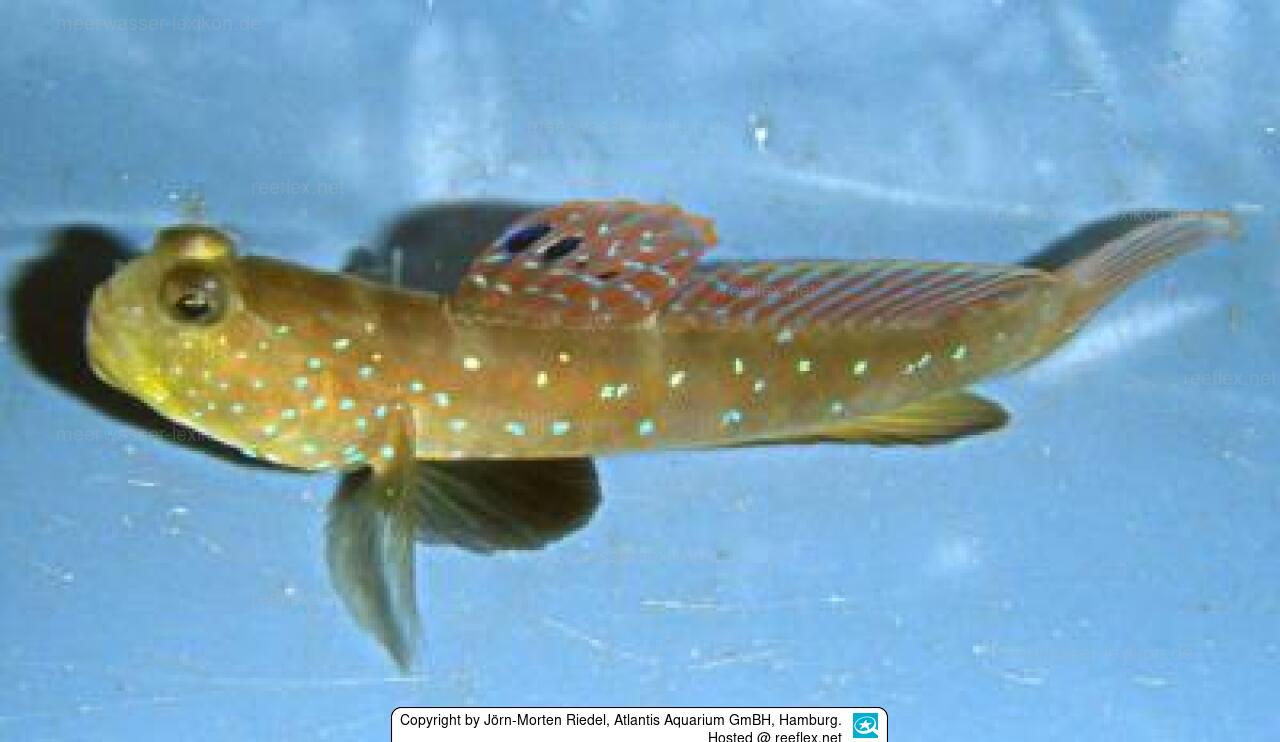Info
The guard goby Cryptocentrus flavus, which originates from Japan, grows considerably larger than the popular yellow goby Cryptocentrus cinctus.
The head is roundish, the body elongated and appears compressed.
Snout blunt, as long as the eye diameter, the front nostril has a short tube near the lip, the rear nostril without a rim, about halfway between the front edge of the eye and the front nostril.
The mouth is slightly slanted, the jaws are subequal and the upper jaw extends to a point below the posterior end of the eye.
On the upper jaw there is an outer row of several larger teeth on each side and an inner band of several irregularly arranged rows of smaller teeth.
On the lower jaw, there is an inner band of several rows of small teeth and an outer row of about 8 pointed teeth extending to the center of the inner band on each side, with the last tooth looking like a canine.
The teeth on both jaws are more or less covered by a dense papillose fringe on the lips.
The gill opening is very wide and extends to a point about halfway between the posterior edge of the eye and the anterior edge of the operculum
There is a spine on the preopercle.
The first dorsal fin is slightly lower than the body height, the second dorsal fin is lower than the body height.
The anal fin is as high as the second dorsal fin,
The caudal fin is rounded and about as long as the head, the pectoral fins do not raise silky, free rays.
The head is naked, the middle part of the neck and the base of the breast are scaleless, the thorax and belly are scaly.
Color:
The body color yellow with many small, blue spots on the head and the front half of the body.
The first dorsal fin is yellow with many light blue spots, the second dorsal fin is yellow with light blue spots on the basal half and horizontal stripes of the same color on the distal half.
Anal fin and pelvic fins yellowish with transverse stripes or small light blue spots. Pectoral fins and caudal fin yellowish.
This species differs from other Cryptocentrus species by the small number of scales (67-71) and its characteristic coloration; the entire body and fins are yellowish with light blue spots. The transverse bands on the body, which can be recognized in most species of this genus, are absent in Cryptocentrus flavus.
Jumping guard
A jumping guard prevents (nocturnal) fish from jumping out.
Wrasses, blennies, hawkfishs and gobies jump out of an unprotected tank in fright if their night rest is disturbed, unfortunately these jumpers are found dried up in the morning on carpets, glass edges or later behind the tank.
https://www.korallenriff.de/en/article/1925_5_Jump_Protection_Solutions_for_Fish_in_the_Aquarium__5_Net_Covers.html
A small night light also helps, as it provides the fish with a means of orientation in the dark!
The head is roundish, the body elongated and appears compressed.
Snout blunt, as long as the eye diameter, the front nostril has a short tube near the lip, the rear nostril without a rim, about halfway between the front edge of the eye and the front nostril.
The mouth is slightly slanted, the jaws are subequal and the upper jaw extends to a point below the posterior end of the eye.
On the upper jaw there is an outer row of several larger teeth on each side and an inner band of several irregularly arranged rows of smaller teeth.
On the lower jaw, there is an inner band of several rows of small teeth and an outer row of about 8 pointed teeth extending to the center of the inner band on each side, with the last tooth looking like a canine.
The teeth on both jaws are more or less covered by a dense papillose fringe on the lips.
The gill opening is very wide and extends to a point about halfway between the posterior edge of the eye and the anterior edge of the operculum
There is a spine on the preopercle.
The first dorsal fin is slightly lower than the body height, the second dorsal fin is lower than the body height.
The anal fin is as high as the second dorsal fin,
The caudal fin is rounded and about as long as the head, the pectoral fins do not raise silky, free rays.
The head is naked, the middle part of the neck and the base of the breast are scaleless, the thorax and belly are scaly.
Color:
The body color yellow with many small, blue spots on the head and the front half of the body.
The first dorsal fin is yellow with many light blue spots, the second dorsal fin is yellow with light blue spots on the basal half and horizontal stripes of the same color on the distal half.
Anal fin and pelvic fins yellowish with transverse stripes or small light blue spots. Pectoral fins and caudal fin yellowish.
This species differs from other Cryptocentrus species by the small number of scales (67-71) and its characteristic coloration; the entire body and fins are yellowish with light blue spots. The transverse bands on the body, which can be recognized in most species of this genus, are absent in Cryptocentrus flavus.
Jumping guard
A jumping guard prevents (nocturnal) fish from jumping out.
Wrasses, blennies, hawkfishs and gobies jump out of an unprotected tank in fright if their night rest is disturbed, unfortunately these jumpers are found dried up in the morning on carpets, glass edges or later behind the tank.
https://www.korallenriff.de/en/article/1925_5_Jump_Protection_Solutions_for_Fish_in_the_Aquarium__5_Net_Covers.html
A small night light also helps, as it provides the fish with a means of orientation in the dark!







 Jörn-Morten Riedel, Atlantis Aquarium GmBH, Hamburg, Deutschland
Jörn-Morten Riedel, Atlantis Aquarium GmBH, Hamburg, Deutschland



























